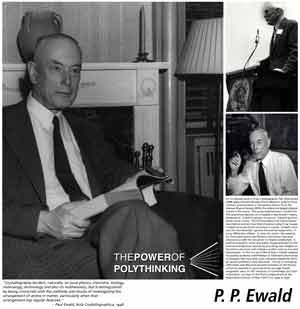
For his lifelong work in X-ray crystallography, Paul Peter Ewald (1888-1985) received the Max Planck Medal in 1978 for extraordinary achievements in Theoretical Physics from the German Physical Society (DPG), the oldest and largest physical society in the world. The unprecedented event marked the first unanimous election of a medalist in the society's history. Esteemed as "a faithful servant of science," Ewald's groundbreaking 1917 thesis, "On the Foundations of Crystal Optics," launched an entirely new field of science using X-ray images to determine the atomic structure of matter. Ewald's work was the first detailed, rigorous theoretical explanation of X-ray diffraction effects. In time, his name-the eponym for the Ewald sphere and Ewald construction-became synonymous with the discipline he helped established. A prolific researcher, writer and editor, Ewald spanned the life sciences and physical sciences by providing new insights on the atomic structures that underpin modern science and solid state physics. In the run up to World War II, Ewald resigned his position as Rector and Professor at Technische Hochschule in Stuttgart, Germany after a law was promulgated by which all Jewish professors were dismissed. Owing to increasing difficulties with National Socialist members of the faculty, whom he opposed with great personal courage, Ewald emigrated west, to the University of Cambridge, and later to Brooklyn, as Head of the Physics Department at the Polytechnic Institute of New York from 1949 to 1958.
"Crystallography borders, naturally, on pure physics, chemistry, biology, mineralogy, technology and also on mathematics, but is distinguished by being concerned with the methods and results of investigating the arrangement of atoms in matter, particularly when that arrangement has regular features." Paul P. Ewald, Acta Crystallographica, 1948